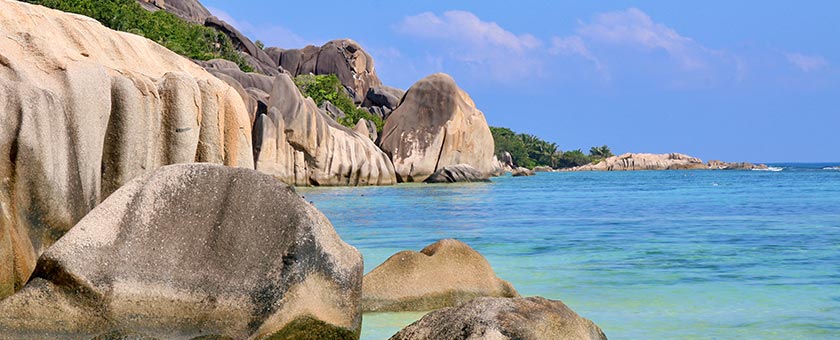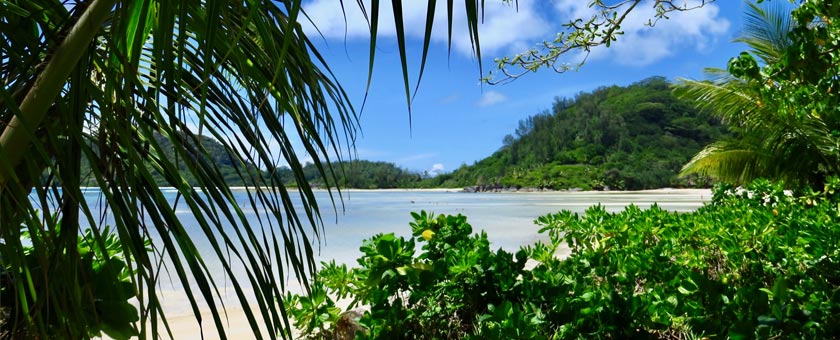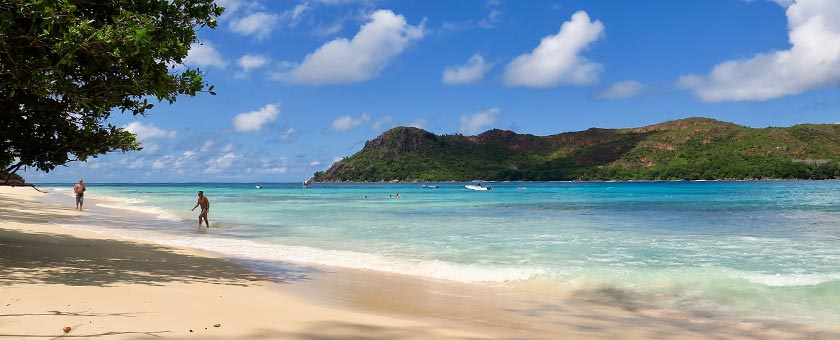203 786 2345 office@eturia.com
Seychelles is a true museum of natural history and a sanctuary for some of the world’s rare species of plants and animals. Here is the only place in the world where you will find the fabulous Coco-de-Mer, which is also the symbol of this country, the fruit with the largest seeds on the ground, a fruit called the walnut of love because of its suggestive form. Only here can you see the Molusca tree, a very rare species, with only eight surviving specimens.
Name: Republic of Seychelles
Capital: Victoria
Location: Island State located in the Indian Ocean, east of Africa and northeast of Madagascar
Main towns: Anse Boileau, Bel Ombre, Beau Vallon, Cascade, Takamaka, Port Glaud, La Passe
Currency: Rupee – SCR
Timezone: UTC +4
Tipping: Tipping is not typically expected in the Seychelles, as a service charge is usually added to/included in the bill. Tipping at hotels is at your discretion, and we’d suggest tipping at the end of your stay. If you’d like the tip to be shared equally by all the hotel staff ‘behind the scenes’, you could place a general tip – the amount is at your discretion – in an envelope and hand it at the reception. For tour guides, if taking a tour, then around USD $5 for a half-day tour and USD $10 for a whole-day tour would be appropriate.
Voltage: Network parameters: 240 V / 50 Hz; G socket is used, you need adapters.
In Seychelles you will also find large colonies of seabirds, singing birds, but also the gray fly, a unique species in the world.
Regardless of the island you choose and whatever activities you pick, Seychelles remains a delightful destination where you will live memorable experiences.
Must see & do:
Lying 4°-11° south of the Equator, in the western Indian Ocean, Seychelles has a tropical climate: warm and humid with strong maritime influences. The temperature is consistently 24-32°C, there is no distinct dry season and there is some humidity at all times.From May to October the south-east trade winds (Southeast Monsoon) bring a relatively dry period. Reaching its peak in July/August, there is little precipitation and temperatures average 27°C, though seas can be a little choppy.
By November (pre-Northwest Monsoon), the winds start to change, bringing light, warmer winds and the start of the main rainy season. During December to March (Northwest Monsoon), Seychelles gets extremely wet, especially in December and January, though the vegetation is lush, the winds generally light and the sun at its warmest. This is also the cyclone season, though only the most remote southern islands are within the cyclone belt.

The island with the finest sanded beaches, La Digue, with only 10 square kilometers, was named after the French explorer Marc-Joseph Marion du Fresne, who arrived on the island in 1768. The beaches of La Digue are perhaps the most beautiful in the world, and attract thousands of tourists from all over the world every year. The white sand, dubbed by the almost unreal turquoise ocean, all guarded by palm trees and coconut trees, form an ideal setting for those who want to spend their holiday on a dreamy beach.

Mahe is the largest island in the entire Seychelles archipelago. Though it is 28 kilometers long and only 8 kilometers wide, the island of Mahe is home to one of the most beautiful national parks, the one around Morne Saeychellois mountain peak. Morne Saeychellois is the highest point of the island and the archipelago, with 905 meters altitude. A day trip through the lush forests of the peak will eventually reveal an incredible panorama of the entire archipelago. The views will make your holiday unforgettable.

Praslin island is home to the incredible Valle de Mai natural park. Valle de Mai is one of those places where wilderness has not been altered by the presence of people. Basically, in any part of this wonderful nature reserve located on Praslin Island, you have the sensation that time has stopped somewhere in the far past. Palm trees and trees that exist only on this island make this place incredible; Valle de Mai was included in UNESCO’s patrimony in 1983. Among these famous trees are the native Coco de Mer, the tree with the largest seeds in the world and with leaves up to 14 meters long and 6 meters wide. Stunning, right?